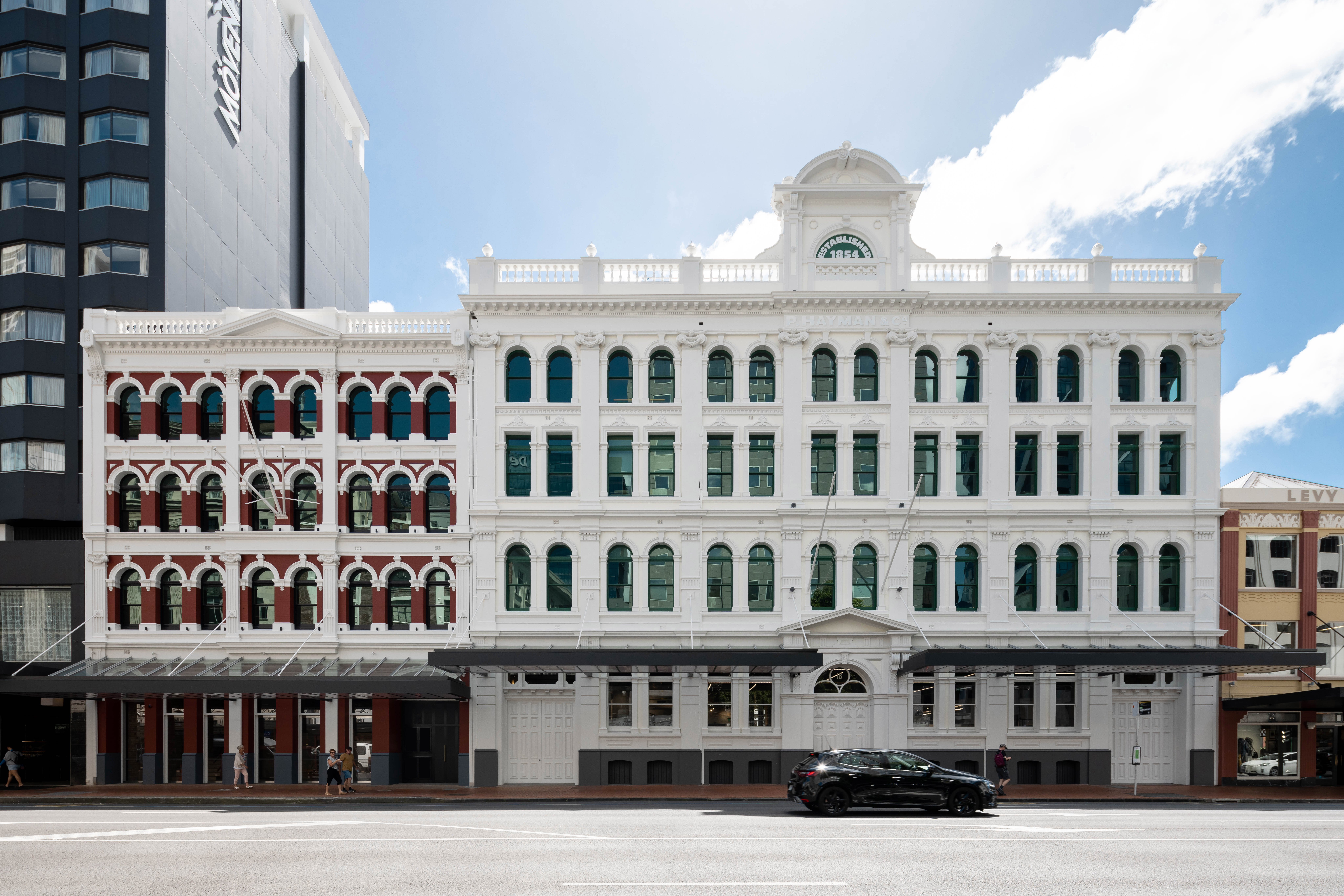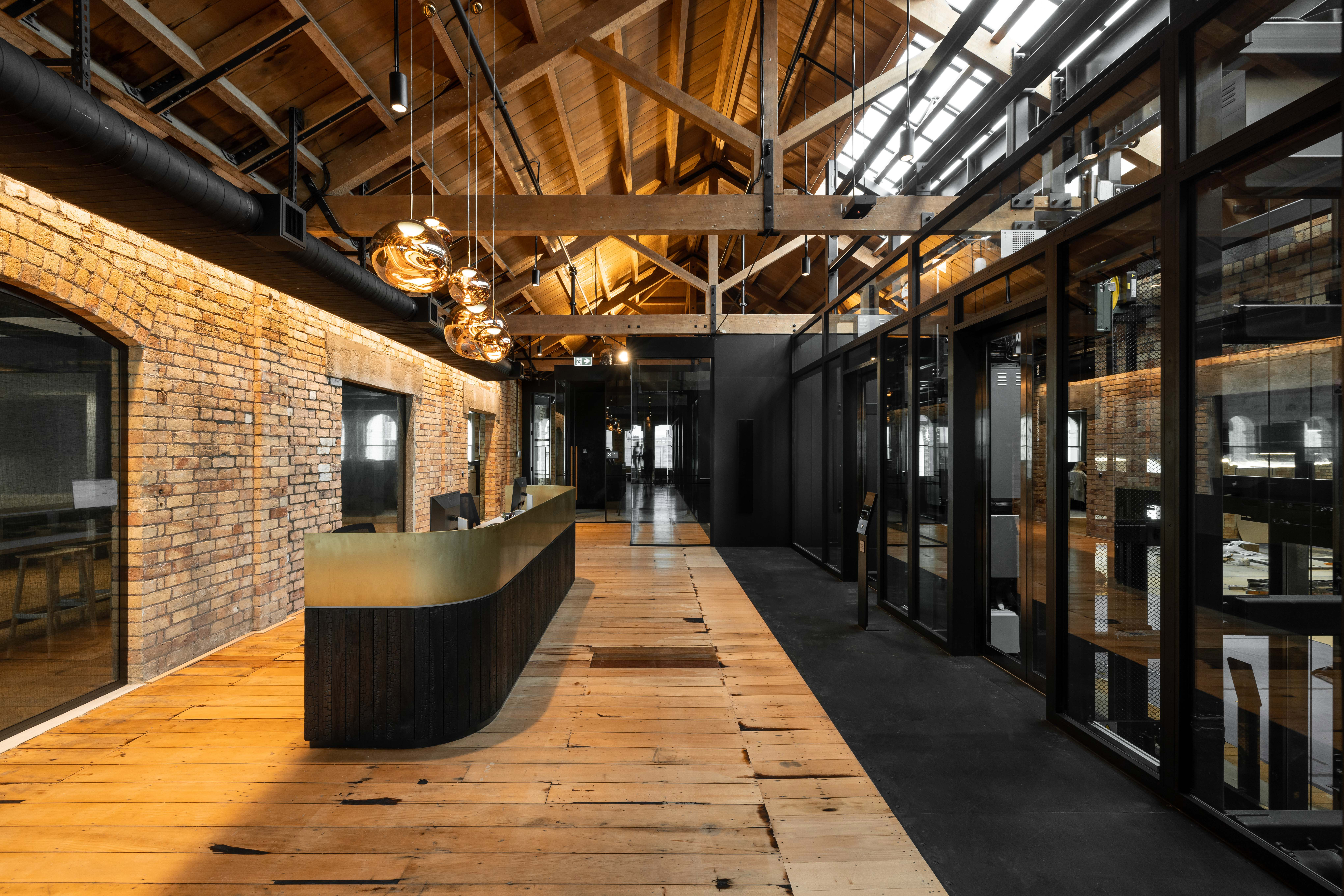Tāmaki Makaurau’s downtown Britomart precinct is quickly becoming home to an array of leading green buildings. The latest addition is the newly refurbished 5 Green Star Hayman Kronfeld building, a beautiful and sustainable amalgamation of two heritage-listed former warehouses.
Essentials
Name: Hayman Kronfeld
Configuration: Hayman Kronfeld is a three-storey building with 1 level of basement located at 10-18 Customs Street East, Auckland. The development comprises ground floor retail and three stories of office.
Occupancy: Now home to six businesses: boutique supermarket Four Square; eatery Daily Bread; the head office of sustainable dairy company Lewis Road Creamery and Southern Pastures; law firm Greenwood Roche; engineering, sustainability and design consultancy Arup, and industrial property experts PFI. Around 250-300 people are based in the building.
Address: 15 Galway Street, Auckland CBD
Project Snapshot
Owner: Cooper and Company
Architect: Peddlethorp
Building Services Engineer: NDY
Structural Engineer: Holmes Consulting Group
Quantity Surveyor: WT Partnership
GSAP: NDY
Project certification: 5 Green Star Design & As Built NZv1.0 Rating (2023)

‘Hayman Kronfeld’ is an ode to the original buildings’ names, the PG Hayman & Co. Warehouse, and the Kronfeld Building. The refurbishment is a first-class example of reducing embodied carbon whilst meeting the needs of a modern office environment that uplifts occupant wellbeing.
Upon entering the building, you can’t help but be wowed by the warm natural light, exposed brickwork and original wooden kauri beams juxtaposed with sleek glass lifts and steel stairs linking the two buildings. A balance of modern industrial design and mixed-material heritage features are beautifully blended, thanks to the vision of architects Peddlethorp and building owner Cooper and Company.
“Listening” to the building was crucial to the design process according to Richard Goldie, Director at Peddlethorp.
“We developed an almost archaeological understanding of the building, helping it to reveal itself to the architect. The materiality of real materials; timber, stone, brick, steel and their assembly, the craft of this, is a joy.”
Campbell Williamson, Development Director at Cooper and Company reflects that stripping back the buildings revealed unique character elements and moments of history.
“Like the Hayman Kronfeld’s charred wooden ceiling from a fire decades ago – which after checking for structural soundness, we chose to preserve and enhance by staining the rest of the ceiling black and then uplighting it with mood lighting to make a stunning feature of it. These are details and stories that the building’s eventual occupants really enjoy,” he muses.
From the outset, solving a fundamental issue of accessibility was a challenge. The conversion of two adjacent buildings with different floor levels required some creative thinking.
“Our solution was to remove entirely one N-S structural bay and insert double-sided lifts, connecting stairs and fire stairs. We rebuilt with this the same materials as the original- so everything in this bay is steel and glass,” says Richard. Salvaged materials from demolition were re-used wherever possible in the project, or recycled materials were sourced, reducing embodied carbon.




Building longevity is a huge sustainability highlight according to Richard, the building is already over a century old and the refurbishment ensures it will most likely last for at least another century. As Richard notes “This is sustainability in action. Not enough emphasis is placed on building in New Zealand on longevity, it changes the whole sustainability profile.”
Senior Sustainability Consultant at NDY, Sanjeev Ganda, was the project GSAP. He notes that “The Life Cycle Assessment (LCA) results reveal significant environmental benefits and upfront carbon reduction through adaptive reuse. The project successfully reduced upfront carbon emissions (A1-A5) by ~70%, saving an estimated 2,300 tonnes of CO2.”
Sanjeev says where new concrete was used, a product with an Environmental Product Declaration (EPD) was selected which provided further carbon savings.
Achieving a 5 Green-Star rating and maintaining sustainable building and design practices were thanks to “the buy-in from all parties involved right through from the design team, construction team and client’s vision,” says Jarrod O’Sullivan, Senior Hydraulic Engineer at NDY.
“As a Building Services Engineer, I see this achievement as a testament to the team's hard work and innovation in implementing energy-efficient solutions, waste reduction measures, and environmentally conscious practices. Hayman Kronfeld is, and should be, the benchmark for heritage refurbishment projects.”
Hayman Kronfeld is Cooper and Company’s third Green Star Built rating, alongside the 5 Green Star East Building and 5 Green Star Hotel Britomart. Their current Kiwi Tavern refurbishment is also targeting a 5 Green Star rating, and all future refurbishments and new buildings in Britomart will target a minimum 5 Green Star rating.
“Achieving high Green Star ratings enables us to pursue wider sustainability goals. For example, in 2022, Britomart Group signed a Green Finance agreement with a coalition of key lending partners. Having Green Star accreditation was critical in this significant achievement,” says Sarah Hull, Director of Sustainability and Brand at Cooper and Company.
Green Highlights:
- Significant reduction of carbon emissions from materials by retaining the existing structure (concrete foundations, basement floor slab, reinforcing steel, brickwork and timber) and reducing finishes through exposed brick walls and floors.
- Waste during construction was mitigated, with 70% of waste diverted from landfill.
- Air quality sensors with digital display screens are located on each floor showing the temperature, humidity, CO2, particulate matter (PM2.5, PM10) and VOC levels. These displays allow for continuous monitoring and raise awareness of indoor environmental quality with building-to-building occupants.
- Energy-efficient LED lighting and HVAC systems, bringing natural light into the building through the insertion of a light well in the centre.
- At least 80% of the building’s gross floor area is covered by a commitment to set measures and report on its environmental performance.



